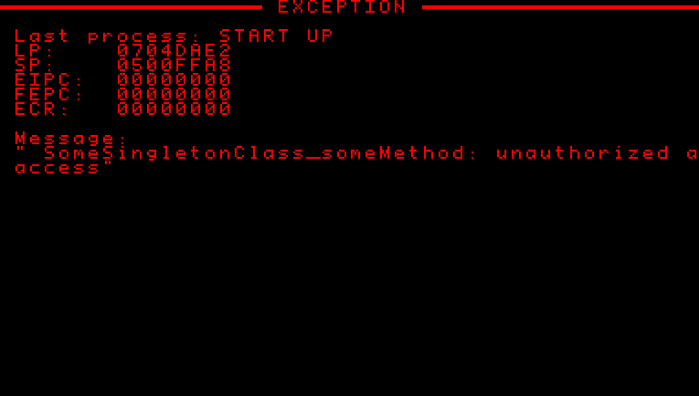Custom Features
Virtual C adds a couple features of its own, thanks to the fact that it is a custom implementation on top of C.
# Class modifiers
There are a few optional class modifiers that can be added to a class declaration:
[modifier] class ClassName: Object
{};
The class modifiers are:
abstractsingletondynamic_singletonstaticextensionmutation
# Abstract classes
The abstract class modifier prevents the creation of class instances through the new keyword, without the requirement of there being at least one pure virtual method.
Classes that have pure virtual methods (by qualifying their declaration with = 0;) are implicitly abstract.
# Singleton classes
The language support the declaration of classes that can only have a single instance and adds automatically the necessary code to prevent more than one instantiation.
The singleton classes’ instances are allocated in global memory.
Since singletons are globally accesible, they put at risk the stability of the program by being modifiable from anywhere. So, it is important to have some mechanism to help preventing as much as possible such modifications.
The transpiler adds the secure keyword to decorate non static methods of singleton classes that should not be called but by specific classes.
secure void SomeSingletonClass::someMethod()
{
[...]
}
Then, to restrict from were it is legal to call such method, an array of classes must be defined globally in non volatitle memory:
const ClassPointer SomSingletonClassAuthorizedClasses[] =
{
typeofclass(SomeOtherClassA),
typeofclass(SomeOtherClassB),
NULL
};
Finally, the following method must be called where appropriate:
SomeSingletonClass::secure(&SomSingletonClassAuthorizedClasses);
After SomeSingletonClass::secure has been called with a non empty array of classes, if any other class besides those listed in the array tries to call SomeSingletonClass::someMethod, an exception like the following will be triggered.

There are some limitations due to the fact that globality cannot really be so easily defeated. And this contraption doesn’t pretend to achieve that. Instead, it is a tool to help preventing potentially dangerous code paths when developing programs using Virtual C.
# Dynamic Singleton classes
These kind of singletons are dynamically allocated. Their destruction is optional, but they are usually manually deleted when not necessary to save on memory. In every other aspect, they are just like normal singletons.
# Static classes
Static classes cannot have instances and all their methods are static.
# Extensions classes
Classes can be extended through the use of the extension keyword. They provide a mechanism to achieve something like runtime method re-implementation on specific virtual methods. Extension classes don’t have to, and cannot, provide a constructor and destructor.
Given some class:
class SomeClass : SomeBaseClass
{
[...]
void someMethod();
virtual bool someVirtualMethod();
[...]
};
The syntax to declare an extension for it is the following:
extension class SomeClassExtension : SomeBaseClass
{
[...]
bool someVirtualMethodOverride();
[...]
};
Entensions classes are meant to provide a mechanism to change at runtime the implementation of a virtual method affecting all the instances of the original class immediately.
To mutate a virtual method, use the following syntax:
SomeClass::mutateMethod(someVirtualMethod, SomeClassExtension::someVirtualMethodOverride);
# Mutation classes
Virtual C implements polymorphism by adding a virtual table pointer to each object, which means that it can be manipulated in real time. Mutation classes permit to override or to extend a class’ functionality by allowing an object’s virtual table pointer to change its target during runtime, making the instance subject to different implementations of virtual methods or capable of reacting to new methods provided by the mutation class.
These classes have the following constraints:
- They have to inherit from a non abstract class
- They have to be data-invariant with respect to the base class (ie: they cannot add attributes of their own)
- They cannot provide a constructor or destructor
- They cannot be directly instantiated
Mutation classes are declared as shown below:
#include <SomeClass.h>
mutation class AMutationOfSomeClass : SomeClass
{
[...]
override void someMethod();
void someNewMethod();
}
Their implementation must contain the following:
#include <AMutationOfSomeClass.h>
mutation class AMutationOfSomeClass;
void AMutationOfSomeClass::someMethod()
{
[...]
}
void AMutationOfSomeClass::someNewMethod()
{
[...]
}
The mutation of an instance of a class is done as follows:
SomeClass::mutateTo(someClassObject, AMutationOfSomeClass::getClass());